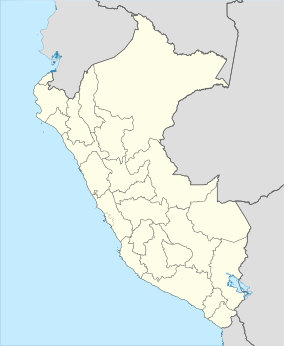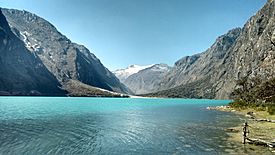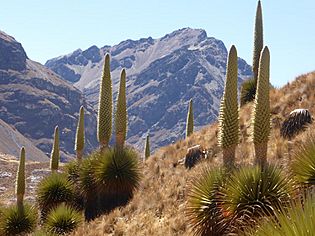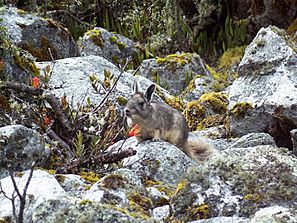Huascarán National Park facts for kids
Quick facts for kids Huascarán National Park |
|
|---|---|
|
IUCN Category II (National Park)
|
|
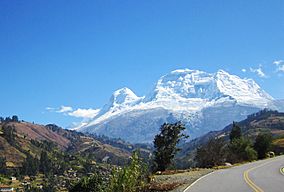
Mount Huascarán, landmark and namesake of Huascarán National Park
|
|
| Location | Peru Ancash |
| Nearest city | Huaraz, Ancash |
| Area | 340,000 ha (840,000 acres) |
| Established | 1 July 1975 |
| Governing body | SERNANP |
| Website | Parque Nacional Huascarán |
| UNESCO World Heritage Site | |
| Criteria | Natural: (vii), (viii) |
| Inscription | 1985 (9th Session) |
| Area | 340,000 ha (840,000 acres) |
Huascarán National Park (Spanish: Parque Nacional Huascarán) is a special nature park in Peru. It's home to most of the Cordillera Blanca mountain range, which is the highest tropical mountain range in the world! This park is part of the central Andes mountains in the Ancash region.
The park is huge, covering about 340,000 hectares (840,000 acres) (that's like 840,000 football fields!). It's looked after by a group called SERNANP, which protects natural areas in Peru. In 1985, UNESCO named it a World Heritage Site. It's also a popular place for mountaineering and has amazing plants and animals. You can find unique plants like the Queen of the Andes and trees like Polylepis. Animals here include spectacled bears, condors, vicunas, and tarucas.
The park stretches about 150 kilometers (93 mi) from north to south. It's about 25 kilometers (16 mi) wide on average. Water from the western side of the Cordillera Blanca flows into the Pacific Ocean through the Santa River. Water from the eastern side goes to the Marañón River, then to the Amazon River, and finally to the Atlantic Ocean.
Contents
Park History: How it Began
People started trying to protect this area in 1960. A senator named Augusto Guzmán Robles suggested creating Huascarán National Park. In 1963, a forestry service made a plan for a "Cordillera Blanca National Park." It would cover about 321,000 hectares (790,000 acres).
In 1966, the government made a rule to stop logging and hunting native animals in the Cordillera Blanca. Later that year, a group was formed in Yungay to support the park. In 1967, some volunteers helped plan the park's borders. They also set up a special zone to protect vicuñas and the Queen of the Andes.
Finally, on July 1, 1975, Huascarán National Park was officially created. It covered 340,000 hectares (840,000 acres). The park's borders were carefully drawn to avoid towns and villages. However, some local communities still raise animals inside the park. Park authorities try to manage this practice.
In 1977, UNESCO also called Huascarán National Park a Biosphere Reserve. This reserve is much larger than the park and includes many nearby towns. In 1985, the park was declared a World Heritage Site.
Park Geography: Mountains and Lakes

Huascarán National Park protects the Cordillera Blanca. This is the world's highest tropical mountain range. The park covers 340,000 hectares (840,000 acres). Its elevation ranges from about 2,500 meters (8,200 ft) to huge snow-capped peaks over 6,000 meters (20,000 ft).
Some of the tallest peaks in the park include Huascarán, which is Peru's highest mountain at 6,768 meters (22,205 ft). Other famous mountains are Huandoy, Copa, and Huantsán.
Inside the park, you'll also find:
- U-shaped valleys, carved by ancient glaciers.
- 660 tropical glaciers, which is the largest glaciated area in the tropics.
- 300 beautiful glacial lakes.
- High flat areas (plateaus) with fast-flowing creeks.
Park Climate: Rainy and Dry Seasons
The park has two main seasons. The rainy season is from December to March. During this time, thunderstorms happen often. The fields and mountains become very green.
The dry season is from April to November. This season brings sunshine almost every day. The nights are clear but cold. During the rainy season, temperatures can go from 5 °C (41 °F) to 20 °C (68 °F). In the dry season, temperatures can range from 2 °C (36 °F) to 24 °C (75 °F).
Park Ecology: Amazing Plants and Animals
Because it's the highest tropical mountain range, the Cordillera Blanca has many different climates. These range from high mountain forests to cold, treeless areas called tundra. The valleys and mountain slopes have scattered high Andean forests and grassy areas called puna grassland.
Park Animals (Fauna)
More than 120 types of birds live here. Some of them are the Andean condor, the torrent duck, the puna tinamou, and the giant hummingbird. You might also see the yanavico and the Andean gull.
Over ten types of mammals have been seen in the park. Several of these are endangered, meaning they are at risk of disappearing. These include the colocolo (a wild cat), the Andean mountain cat, and the spectacled bear. Other mammals are the taruca deer, the vicuña, the white-tailed deer, the puma, and the northern viscacha. You might also spot a long-tailed weasel, a hog-nosed skunk, or an Andean fox.
Park Plants (Flora)
About 779 different plant species have been found in the park. The most famous is the queen of the Andes (Puya raimondii). This plant is very special and protected.
Other plants in the park include:
- Polylepis racemosa
- Escallonia resinosa
- Alnus acuminata
- Senna birostris
- Vallea stipularis
- Different types of Lupinus
- Vaccinium floribundum
- Grasses like Calamagrostis vicunarum, Festuca dolichophylla, and Jarava ichu
- Azorella plants
Fun Activities in the Park
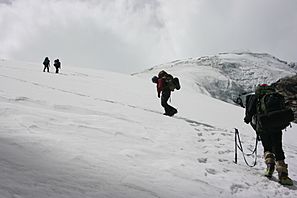
Visitors to Huascarán National Park can do many exciting things!
- Hiking and trekking: There are 25 different hiking trails.
- Wildlife watching: Spot amazing birds and mammals.
- Mountain biking: Explore the trails on a bike.
- Skiing: Enjoy the snow-capped peaks.
- Mountaineering: The park has 102 spots for climbing mountains.
- Cultural tourism: Learn about the history of the area.
The park is also a great place for scientists to study. They can research things like meteorology (weather), geology (rocks), glaciology (glaciers), botany (plants), zoology (animals), and ecology (how living things interact).
There are 33 archaeological sites inside the park. These include ancient cave paintings, old settlements, farming terraces, tombs, and fortresses. There's even an old road from before Columbus, connecting the towns of Olleros and Chavin.
Challenges for the Park
Huascarán National Park faces some challenges.
- Glacier retreat: Glaciers are shrinking because of global warming.
- Mining: Some mining operations, including those that are not allowed, can harm the environment.
- Habitat loss: Some natural areas are being turned into farmland or pastures. This can happen because local communities have long-standing rights to use the land.
Protecting the Park
In the 1960s, animals like the vicuña were hunted too much and were in danger. This led to efforts to protect the area. Huascarán National Park was officially created in 1975. In 1977, UNESCO also recognized it as a Biosphere Reserve.
Today, the park is managed by SERNANP, a government group that protects natural areas. They work to keep the park safe and healthy. The park needs enough money and staff to deal with its challenges. There are also some communities living near or inside the park. The park tries to work with them to manage how natural resources are used, especially for grazing animals.
The park's beautiful scenery and old archaeological sites attract many visitors. Tourism can help the local economy and teach people about conservation. However, it's important to manage tourism carefully to avoid harming the environment or cultural sites.
See also
 In Spanish: Parque nacional Huascarán para niños
In Spanish: Parque nacional Huascarán para niños
- Ancash Region
- Cordillera Blanca
- Tourism in Peru


